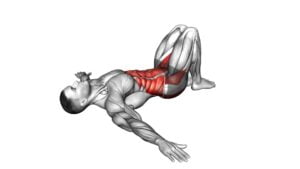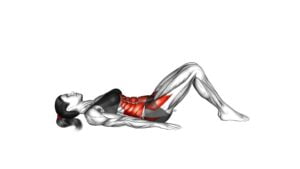Sitting Windshield Wipers (male) – Video Exercise Guide & Tips

Looking to strengthen your core and improve your flexibility? Look no further than sitting windshield wipers!
Watch This Exercise Video
In this video exercise guide, we'll show you the proper form and technique for performing this challenging yet effective exercise. Whether you're a beginner or an advanced fitness enthusiast, we've got modifications and progressions to suit your level.
Avoid common mistakes and learn valuable tips to make the most out of your sitting windshield wipers.
Get ready to take your fitness routine to the next level!
Key Takeaways
- Sitting windshield wipers can strengthen and stabilize core muscles.
- Proper form and technique, such as keeping the spine straight and engaging core muscles, is essential for this exercise.
- Modifications and progressions, such as using resistance bands or ankle weights, can increase the difficulty of sitting windshield wipers.
- Common mistakes to avoid include losing control of legs, neglecting proper form, and using momentum instead of controlled movements.
Benefits of Sitting Windshield Wipers
Improve your core strength and flexibility by incorporating sitting windshield wipers into your workout routine. This exercise offers a range of benefits for your core stability.
By engaging your abdominal muscles, obliques, and lower back, sitting windshield wipers help to strengthen and stabilize your core, which is essential for overall body strength and balance.
One of the core stability benefits of sitting windshield wipers is improved posture. As you perform this exercise, you'll develop stronger core muscles, which can help support your spine and improve your posture. This can lead to reduced back pain and discomfort.
In addition to core stability, sitting windshield wipers also aid in injury prevention. Through the controlled movement of your legs, you promote hip mobility and stability. This can help prevent injuries and discomfort in the hips, lower back, and knees.
Incorporating sitting windshield wipers into your workout routine can also enhance your flexibility. As you perform the exercise, you'll be stretching your hip muscles and improving your range of motion.
Proper Form and Technique for Sitting Windshield Wipers
To properly perform sitting windshield wipers, you should begin by assuming a seated position with your legs extended in front of you. This exercise not only works your core muscles but also helps improve flexibility in your hips and lower back. Here are some tips to ensure proper form and technique:
- Keep your spine straight: Sit tall and engage your core muscles to maintain a neutral spine throughout the exercise. Avoid slouching or rounding your back.
- Control your movements: Slowly lower your legs to one side, keeping them together, until they're as close to the ground as possible without touching. Then, return them to the starting position and repeat on the other side. Focus on maintaining control and avoiding any jerky or sudden movements.
- Modify as needed: If you find it challenging to keep your legs straight or lower them all the way to the ground, you can bend your knees slightly or reduce the range of motion. As you build strength and flexibility, you can gradually increase the difficulty of the exercise.
To improve flexibility for sitting windshield wipers, incorporate stretches and exercises that target the muscles involved, such as the hip flexors, hamstrings, and obliques. Regularly practicing these movements will gradually increase your range of motion and make performing sitting windshield wipers easier and more effective.
Modifications and Progressions for Sitting Windshield Wipers
Modify and progress your sitting windshield wipers by incorporating variations that challenge your core muscles and improve flexibility.
To add modifications, you can start by using a resistance band around your feet to increase the difficulty. This will require more control and stability as you perform the exercise.
Another modification is extending your legs fully, keeping them straight throughout the movement. This will engage your lower abs and increase the intensity.
For advanced variations, you can try performing the windshield wipers with ankle weights. The added resistance will further challenge your core and improve strength.
Another advanced variation is to perform the exercise on an unstable surface, such as a stability ball or a Bosu ball. This will require even more stability and coordination, engaging additional muscles.
Remember to start with the modifications and progress to the advanced variations as you gain strength and stability. Listen to your body and only progress when you feel comfortable and confident in your abilities. Always maintain proper form and technique to avoid injury.
Now that you know how to modify and progress your sitting windshield wipers, let's move on to the next section where we'll discuss common mistakes to avoid during this exercise.
Common Mistakes to Avoid During Sitting Windshield Wipers
One common mistake to avoid during sitting windshield wipers is allowing your legs to swing uncontrollably, which can compromise the effectiveness of the exercise and increase the risk of injury. To ensure you're performing the exercise correctly and maximizing its benefits, here are three common mistakes to avoid:
- Losing control of your legs:
It's crucial to maintain control and stability throughout the movement. Avoid swinging your legs too forcefully or allowing them to drop abruptly. Instead, focus on engaging your core muscles to control the movement and keep your legs stable.
- Neglecting proper form:
Proper technique is essential to target the intended muscles and avoid strain. Make sure to keep your back straight, shoulders relaxed, and engage your core throughout the exercise. Avoid rounding your back or straining your neck as this can lead to discomfort and potential injuries.
- Using momentum:
This exercise is all about controlled movements, so avoid relying on momentum to swing your legs. Instead, focus on using your abdominal muscles to initiate the movement and control the range of motion. This won't only increase the effectiveness of the exercise but also reduce the risk of strain or injury.
By avoiding these common mistakes and focusing on proper technique, you can ensure that you're getting the most out of your sitting windshield wipers. Emphasizing control, form, and precision will help you achieve better results and maintain a safe exercise routine.
Keep pushing yourself and enjoy the benefits of this challenging exercise!
Tips for Incorporating Sitting Windshield Wipers Into Your Fitness Routine
To effectively incorporate sitting windshield wipers into your fitness routine, focus on proper technique and gradually increase the difficulty level for a challenging and rewarding workout. If you're a beginner, start by incorporating sitting windshield wipers into your workout routine two to three times a week.
Begin by sitting on a mat with your legs extended in front of you and your hands resting on the floor beside your hips. Engage your core and lean back slightly, keeping your back straight. Lift your legs off the ground and bring your knees towards your chest. From here, slowly lower your legs to one side, keeping them as straight as possible, and then return to the starting position. Repeat on the other side.
As you become more comfortable with the exercise, you can increase the difficulty by adding ankle weights or using a stability ball between your legs. This will further challenge your core stability and increase flexibility in your hips and lower back.
Remember to always listen to your body and stop if you experience any pain or discomfort. By incorporating sitting windshield wipers into your routine and gradually increasing the difficulty level, you can improve your overall fitness and increase flexibility in a safe and effective manner.
Frequently Asked Questions
Can Sitting Windshield Wipers Help With Lower Back Pain?
Sitting windshield wipers can be beneficial for your lower back pain. By engaging your core muscles, these exercises help strengthen your core and improve postural alignment.
By incorporating sitting windshield wipers into your workout routine, you can target the muscles that support your spine, reducing the strain on your lower back. This exercise can provide relief and prevent further discomfort.
Include sitting windshield wipers in your fitness regimen to promote core strength and alleviate lower back pain.
How Many Calories Can You Burn by Doing Sitting Windshield Wipers?
By doing sitting windshield wipers, you can burn a significant amount of calories. This sitting exercise is great for engaging your core muscles and improving your lower back strength.
While the exact number of calories burned will vary depending on factors like your weight and intensity level, this exercise can help you achieve your calorie-burning goals.
Are There Any Age Restrictions or Limitations for Performing Sitting Windshield Wipers?
There are no specific age restrictions or limitations for performing sitting windshield wipers. However, it's important to consider your individual fitness level and any pre-existing medical conditions.
Always consult with a healthcare professional before starting any new exercise routine, especially if you have concerns about age-related limitations. Remember, age should never be a barrier to staying active and maintaining a healthy lifestyle.
Listen to your body and modify the exercise as needed to ensure your safety and enjoyment.
Can Sitting Windshield Wipers Help Improve Flexibility and Range of Motion?
Sitting windshield wipers can definitely help improve your flexibility and range of motion, particularly in your hips. By performing this exercise, you're actively engaging your hip muscles and promoting their mobility.
Seated exercises, like sitting windshield wipers, offer numerous benefits such as increased joint stability, improved posture, and reduced risk of injury.
Is It Necessary to Use Any Equipment or Props While Performing Sitting Windshield Wipers?
When doing sitting windshield wipers, you don't need any equipment or props. You can do them on a mat or on the floor.
It's a great exercise to improve flexibility and range of motion in your hips and lower back. However, there are alternatives if you find it too challenging.
Remember to avoid common mistakes like using momentum or lifting your feet too high. Keep practicing and you'll see progress!
Conclusion
Incorporating sitting windshield wipers into your fitness routine can provide a range of benefits, including improved core strength and stability. By following proper form and technique, avoiding common mistakes, and making modifications as needed, you can safely progress in this exercise.
Remember to stay consistent and challenge yourself to continue pushing your limits. With dedication and practice, you'll soon reap the rewards of this effective workout.
Stay motivated and enjoy the results of your hard work!

Author
Years ago, the spark of my life’s passion ignited in my mind the moment I stepped into the local gym for the first time. The inaugural bead of perspiration, the initial endeavor, the very first surge of endorphins, and a sense of pride that washed over me post-workout marked the beginning of my deep-seated interest in strength sports, fitness, and sports nutrition. This very curiosity blossomed rapidly into a profound fascination, propelling me to earn a Master’s degree in Physical Education from the Academy of Physical Education in Krakow, followed by a Sports Manager diploma from the Jagiellonian University. My journey of growth led me to gain more specialized qualifications, such as being a certified personal trainer with a focus on sports dietetics, a lifeguard, and an instructor for wellness and corrective gymnastics. Theoretical knowledge paired seamlessly with practical experience, reinforcing my belief that the transformation of individuals under my guidance was also a reflection of my personal growth. This belief holds true even today. Each day, I strive to push the boundaries and explore new realms. These realms gently elevate me to greater heights. The unique combination of passion for my field and the continuous quest for growth fuels my drive to break new ground.







